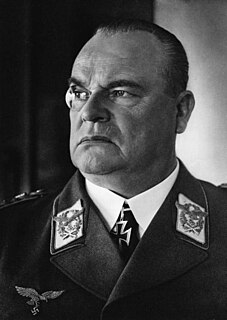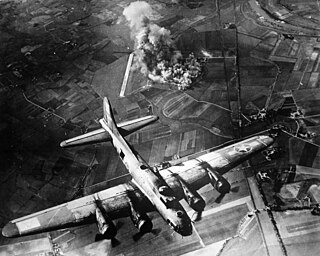Related Research Articles

The Battle of Britain was a military campaign of the Second World War, in which the Royal Air Force (RAF) and the Fleet Air Arm (FAA) of the Royal Navy defended the United Kingdom (UK) against large-scale attacks by Nazi Germany's air force, the Luftwaffe. It has been described as the first major military campaign fought entirely by air forces. The British officially recognise the battle's duration as being from 10 July until 31 October 1940, which overlaps the period of large-scale night attacks known as the Blitz, that lasted from 7 September 1940 to 11 May 1941. German historians do not accept this subdivision and regard the battle as a single campaign lasting from July 1940 to June 1941, including the Blitz.
Bomber Command is an organisational military unit, generally subordinate to the air force of a country. The most famous ones were in Britain and the United States. A Bomber Command is generally used for strategic bombing, and is composed of bombers.

The Eighth Air Force is a numbered air force (NAF) of the United States Air Force's Air Force Global Strike Command (AFGSC). It is headquartered at Barksdale Air Force Base, Louisiana. The command serves as Air Forces Strategic – Global Strike, one of the air components of United States Strategic Command (USSTRATCOM). The Eighth Air Force includes the heart of America's heavy bomber force: the B-2 Spirit stealth bomber, the B-1 Lancer supersonic bomber, and the B-52 Stratofortress heavy bomber aircraft.

Hugo Sperrle was a German military aviator in World War I and a Generalfeldmarschall in the Luftwaffe during World War II.

The second Schweinfurt raid, also called Black Thursday, was a World War II air battle that took place on 14 October 1943, over Nazi Germany between forces of the United States 8th Air Force and German Luftwaffe fighter arm (Jagdwaffe). The American bombers conducted a strategic bombing raid on ball bearing factories to reduce production of these vital parts for all manner of war machines. This was the second attack on the factories at Schweinfurt. American wartime intelligence claimed the first Schweinfurt–Regensburg mission in August had reduced bearing production by 34 percent but had cost many bombers. A planned follow-up raid had to be postponed to rebuild American forces.
The Pathfinders were target-marking squadrons in RAF Bomber Command during World War II. They located and marked targets with flares, which a main bomber force could aim at, increasing the accuracy of their bombing. The Pathfinders were normally the first to receive new blind bombing aids like Gee, Oboe and the H2S radar.

The Pointblank directive authorised the initiation of Operation Pointblank, the code name for the primary portion of the Allied Combined Bomber Offensive intended to cripple or destroy the German aircraft fighter strength, thus drawing it away from frontline operations and ensuring it would not be an obstacle to the invasion of Northwest Europe. The Pointblank directive of 14 June 1943 ordered RAF Bomber Command and the U.S. Eighth Air Force to bomb specific targets such as aircraft factories, and the order was confirmed when the Allies met at the Quebec Conference, 1943.
Big Week or Operation Argument was a sequence of raids by the United States Army Air Forces and RAF Bomber Command from 20 to 25 February 1944, as part of the European strategic bombing campaign against Nazi Germany. The planners intended to attack the German aircraft industry to lure the Luftwaffe into a decisive battle where the Luftwaffe could be damaged so badly that the Allies would achieve air superiority which would ensure success of the invasion of continental Europe.

The Schweinfurt–Regensburg mission was a strategic bombing mission during World War II carried out by Boeing B-17 Flying Fortress heavy bombers of the U.S. Army Air Forces on August 17, 1943. The mission was an ambitious plan to cripple the German aircraft industry; it was also known as the "double-strike mission" because it entailed two large forces of bombers attacking separate targets in order to disperse fighter reaction by the Luftwaffe. It was also the first American "shuttle" mission, in which all or part of a mission landed at a different field and later bombed another target before returning to its base.
Karl-Heinz Greisert was an officer in the Luftwaffe. He served in the Condor Legion during the Spanish Civil War. During the Second World War he participated in the air battles over France and England. He was made commanding officer of II Gruppe of Jagdgeschwader 2. For three months he served as acting commander of JG 2 after his commander had been killed in action. Following the Battle of Britain he remained in the west and was involved in a number of air battles over the English Channel and northern France. In June 1942 he was transferred to the eastern Front where he took command of III Gruppe of JG 3. A month later he was killed in action in the course of a low altitude air battle. He was credited with 34 victories, and was a recipient of the Spanish Cross and the German Cross in Gold.

Jagdgeschwader 26 (JG 26) Schlageter was a German fighter-wing of World War II. It was named after Albert Leo Schlageter, a World War I veteran, Freikorps member, and posthumous Nazi martyr, arrested and executed by the French for sabotage in 1923. The wing fought predominantly against the Western Allies.

The Combined Bomber Offensive (CBO) was an Allied offensive of strategic bombing during World War II in Europe. The primary portion of the CBO was against Luftwaffe targets which was the highest priority from June 1943 to 1 April 1944. The subsequent highest priority campaigns were against V-weapon installations and petroleum, oil, and lubrication (POL) plants. Additional CBO targets included railyards and other transportation targets, particularly prior to the invasion of Normandy and, along with army equipment, in the final stages of the war in Europe.

Adlertag was the first day of Unternehmen Adlerangriff, which was the codename of a military operation by Nazi Germany's Luftwaffe to destroy the British Royal Air Force (RAF). By June 1940, the Allies had been defeated in Western Europe and Scandinavia. Rather than come to terms with Germany, Britain rejected all overtures for a negotiated peace.

The Defence of the Reich is the name given to the strategic defensive aerial campaign fought by the Luftwaffe air arm of the combined Wehrmacht armed forces of Nazi Germany over German-occupied Europe and Nazi Germany during World War II. Its aim was to prevent the destruction of German civilians, military and civil industries by the Western Allies. The day and night air battles over Germany during the war involved thousands of aircraft, units and aerial engagements to counter the Allied strategic bombing campaign. The campaign was one of the longest in the history of aerial warfare and with the Battle of the Atlantic and the Allied Blockade of Germany was the longest of the war. The Luftwaffe fighter force defended the airspace of German-occupied territory against attack, first by RAF Bomber Command and then against the United States Army Air Forces (USAAF).
During the Second World War the German Luftwaffe was the main support weapon of the German Army (Heer). It fought and supported the Wehrmacht's war effort throughout the six years of conflict and contributed to much of Nazi Germany's early successes in 1939–1942. After the turn in Germany's fortunes, it continued to support the German ground forces until the German surrender in May 1945.

The Battle of the Heligoland Bight was the first "named" air battle of the Second World War, which began the longest air campaign of the war, the Defence of the Reich. On 3 September 1939, the United Kingdom declared war on Nazi Germany after the German invasion of Poland, which started the European War. The British did not assist Poland by land or sea but RAF Bomber Command flew several missions against German targets. A number of these air raids were directed at Kriegsmarine warships in German ports to prevent their use in the Battle of the Atlantic. With the front lines static between September 1939 and May 1940, a period known as the "Phoney War" set in, with little fighting on land or in the air.

Circus was the codename given to operations by the Royal Air Force (RAF) during the Second World War where bombers, with a mass escort of fighters, were sent over continental Europe to bring Luftwaffe fighters into combat. These were usually formations of 20 to 30 bombers escorted by up to 16 squadrons of escort fighters. Bomber formations of this size could not be ignored by the Luftwaffe.

The RAF bombing raid against the Schneider Works at Le Creusot, known as Operation Robinson, was undertaken during the daylight hours of 17 October 1942. The mission was assigned to No. 5 Group, which had converted to the new Avro Lancaster. The Lancaster’s large lift capacity and high speed gave reason for optimism that the raid might succeed.

The Augsburg Raid, also referred to as Operation Margin, was a bombing raid made by the RAF on the MAN U-boat engine plant in Augsburg undertaken during the daylight hours of 17 April 1942. The mission was assigned to No. 44 (Rhodesia) Squadron and No. 97 Squadron, both of which were equipped with the new Avro Lancaster. The speed of the Lancaster and its large bombload capacity gave reason for optimism that the raid might succeed. It was the first of the attacks upon German industry in Augsburg.
References
- ↑ Ashworth 1995, pp. 24–26.
- ↑ Maynard 1996, pp. 22–23.
- ↑ Murray 1989, p. 128.